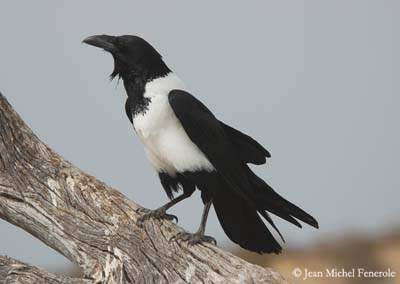
DIET:
The Pied Crow feeds on numerous invertebrates such as insects, spiders and molluscs. It also takes small vertebrates such as rodents, birds, frogs, lizards and fish. Bats and small birds can be caught in flight.
It also scavenges at rubbish dumps and patrols for roadside kills. This crow feeds on plant items such as seeds, roots and fruits, dates and oil palm nuts, potatoes and rice.
PROTECTION / THREATS / STATUS:
The Pied Crow is common and widespread, and may be locally abundant.
Thanks to its omnivorous diet and its tolerance of humans, this bird is not threatened at this moment.
Fr: Corbeau pie
All : Schildrabe
Esp : Cuervo Pío
Ital: Corvo bianco e nero
Nd: Schildraaf
Sd: Svartvit kråka
Photographers:
Marc Chrétien
MURINUS
Jean Michel Fenerole
Photos d’Oiseaux
Steve Garvie
RAINBIRDER Photo galleries
Jean Marc Rabby
Des Ailes et des Plumes
Callie de Wet
GALLERY
Text by Nicole Bouglouan
Sources:
HANDBOOK OF THE BIRDS OF THE WORLD Vol 14 by Josep del Hoyo-Andrew Elliot-David Christie - Lynx Edicions –
ISBN: 9788496553507
L’ENCYCLOPEDIE MONDIALE DES OISEAUX - Dr Christopher M. Perrins - BORDAS - ISBN: 2040185607
BIRDS OF THE GAMBIA AND SENEGAL by Clive Barlow and Tim Wacher – Helm Field guides – ISBN: 0713675497
BIRDS OF AFRICA SOUTH OF THE SAHARA by Ian Sinclair and Peter Ryan - Princeton University Press Princeton and Oxford - ISBN: 0691118159
Wikipedia (Wikipedia, The Free Encyclopedia)
Pied Crow
Corvus albus
Passeriforme Order – Corvidae Family
BIOMETRICS:
Length: 45 cm
Weight: 400-700 g
DESCRIPTION:
This black and white crow is highly adaptable to several habitats, including cities and towns where it finds food and garbage.
Both adults are similar and have black head, neck and upper breast, with blue and purple gloss. The black throat feathers are longer.
These black parts contrast strongly with the white collar on upper mantle, extending to the underparts on breast, body sides and axillaries.
The rest of the plumage, lower back to uppertail coverts on upperparts, and lower belly and vent on underparts is black, but less glossy than the head. Wings and tail are black with blue and purple gloss.

The strong bill, legs and feet are black. Eyes are dark brown.
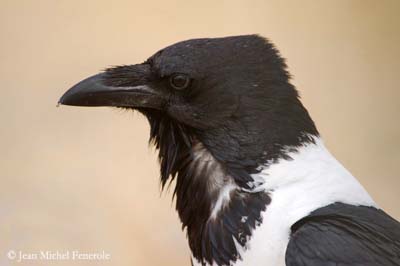
The juvenile has duller black plumage and the demarcation between the black and white areas is less contrasted with grey-tipped feathers.
VOICE: SOUNDS BY XENO-CANTO
As many crows, the Pied Crow utters the typical guttural “kraaak”, or deeper “rrawrr”, or short “krow”. We can also hear a flat “raa” often prolonged into a catlike “raaaaeow”.
It also gives dry rattle “torrrrrh” or “tarrrrrh”.
Other sounds are nasal, hollow, throaty and flat, often accompanied by head-bobbing and tail movements.
HABITAT:
The Pied Crow frequents mainly open areas and grasslands, open country with trees, clearings, savannahs, but also riverbanks and lakeshores.
This species can be seen near humans, in villages, towns and cities where it may find rubbish dumps and slaughterhouses.
However, the Pied Crow does not frequent dense forest, deserts or highly mountainous areas, but according to the region, it is visible from sea-level up to 3700 metres of elevation in Ethiopia, but it usually occurs at lower elevation.
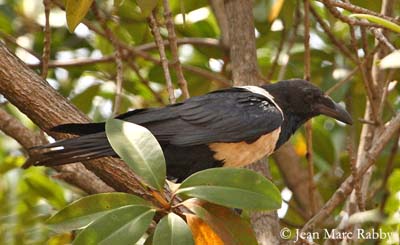
RANGE:
The Pied Crow occurs in almost the whole sub-Saharan Africa, except some regions of Eritrea, Ethiopia and Somalia, the most arid regions of Namibia, Botswana and Kalahari basin, and the higher elevations of Lesotho.
It is present on the islands off Tanzania and on Madagascar.
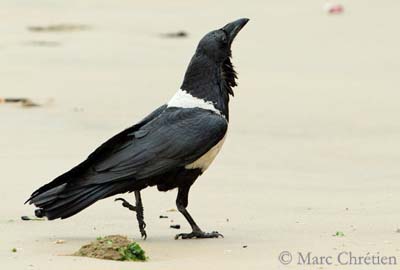
BEHAVIOUR:
The Pied Crow is omnivorous, feeding on various insects and molluscs. It also takes small vertebrates such as amphibians and lizards, rodents, small birds and fish. It may sometimes catch insects, birds and bats in flight. It takes roadside kills and frequents the rubbish dumps with raptors and marabous.
In the southern parts of the range, it feeds on plant items such as various seeds, roots and fruits.
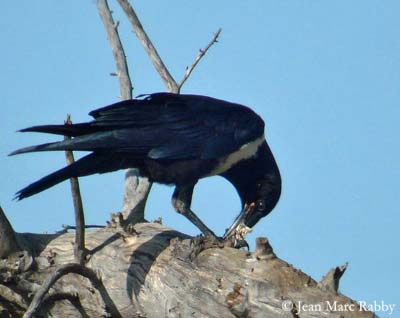
The Pied Crow is known to raid the bird’s nest, especially in heronries where it takes eggs and nestlings.
It follows the bush fires for insects, and the plough for invertebrates.
It has been reported to break eggs of Ostrich from height at dropping stones.
The Pied Crow forages in pairs and in small groups, but they can gather at abundant food sources in large flocks.
They sleep at communal roosts in large trees in urban parks where many hundreds of birds can be seen.
The Pied Crow is well known for mobbing larger birds, from small birds of prey to large vultures. But it may be mobbed itself by smaller birds. It also pirates seabirds for food.
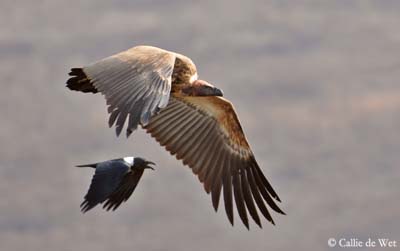
At the beginning of the breeding season, the Pied Crow performs courtship displays. The male struts close and around the female and fluffs the nape and throat feathers. The bill is lowered. It also bows while uttering rattling calls.
In response to these displays, the female performs submission display. She crouches and quivers her wings, a typical posture to invite the male to mate.
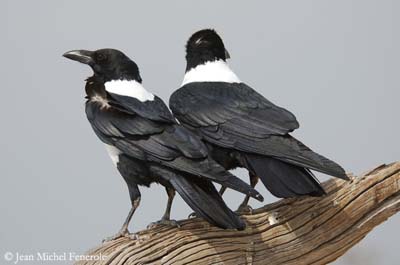
The Pied Crow is mainly sedentary within its wide range. Some local or seasonal movements occur according to the range. Post breeding movements are observed, but adults are probably sedentary, whereas the young move into new territories.
FLIGHT:
The Pied Crow performs long, continuous and strong flights with powerful and steady wing beats.
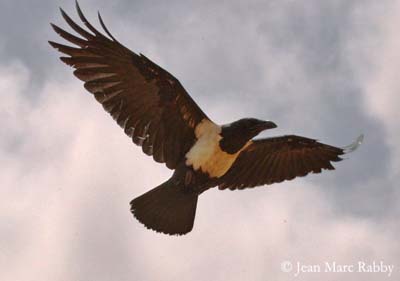
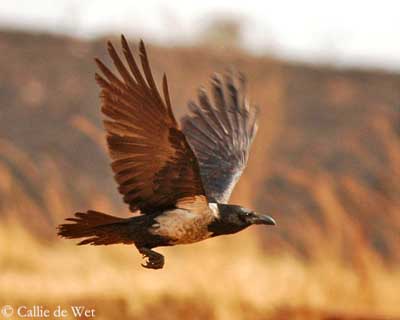
REPRODUCTION:
Breeding season varies according to the range and the rains.
The Pied Crows are monogamous, and pair-bonds probably last all their life.
This species is solitary nester, and both adults build the nest which is a bulky structure made with sticks and roots. The deep cup is lined with various items such as mud, dung, wool, string and grasses. The nest is often placed high in tree fork, telephone poles, pylons, tall buildings and rarely on cliff ledges.
Female lays 4-5 eggs. Both sexes incubate but mainly the female, during 18-19 days. Parents feed the young which remain at nest about 35-45 days.
The Pied Crow’s nests can be occasionally parasitized by the Great Spotted Cuckoo (Clamator glandarius).
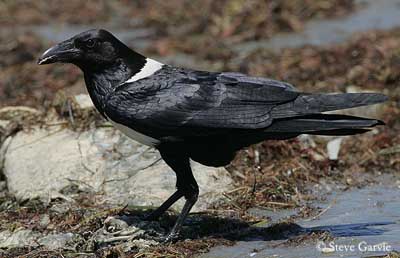
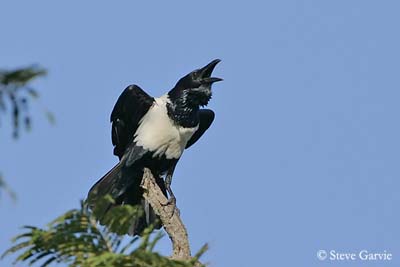
Pied Crow and Cape Vulture
(Gyps Coprotheres)